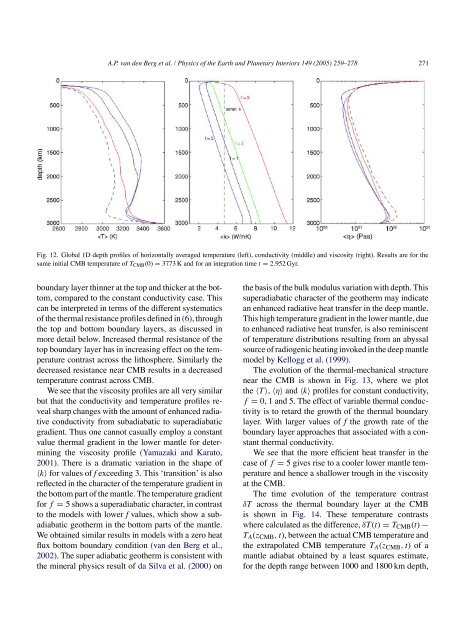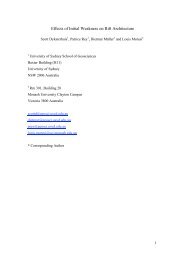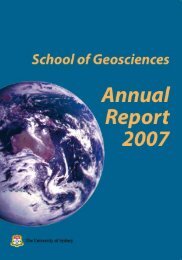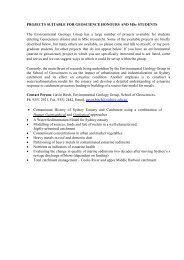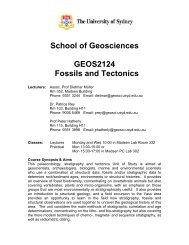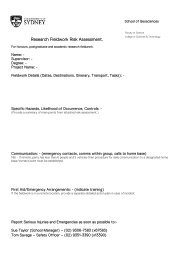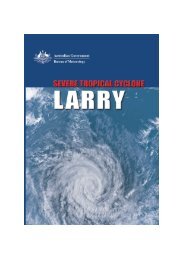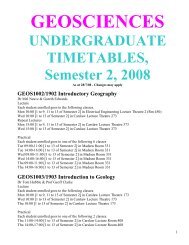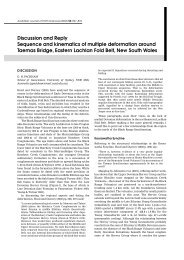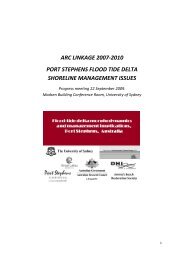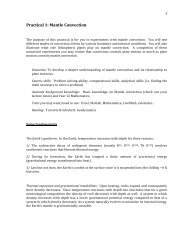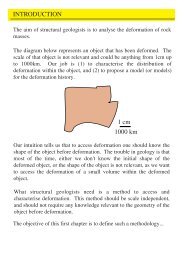van den Berg et al., 2005, Earth Planetary Science Letters.
van den Berg et al., 2005, Earth Planetary Science Letters.
van den Berg et al., 2005, Earth Planetary Science Letters.
Create successful ePaper yourself
Turn your PDF publications into a flip-book with our unique Google optimized e-Paper software.
A.P. <strong>van</strong> <strong>den</strong> <strong>Berg</strong> <strong>et</strong> <strong>al</strong>. / Physics of the <strong>Earth</strong> and Plan<strong>et</strong>ary Interiors 149 (<strong>2005</strong>) 259–278 271<br />
Fig. 12. Glob<strong>al</strong> 1D depth profiles of horizont<strong>al</strong>ly averaged temperature (left), conductivity (middle) and viscosity (right). Results are for the<br />
same initi<strong>al</strong> CMB temperature of T CMB (0) = 3773 K and for an integration time t = 2.952 Gyr.<br />
boundary layer thinner at the top and thicker at the bottom,<br />
compared to the constant conductivity case. This<br />
can be interpr<strong>et</strong>ed in terms of the different systematics<br />
of the therm<strong>al</strong> resistance profiles defined in (6), through<br />
the top and bottom boundary layers, as discussed in<br />
more d<strong>et</strong>ail below. Increased therm<strong>al</strong> resistance of the<br />
top boundary layer has in increasing effect on the temperature<br />
contrast across the lithosphere. Similarly the<br />
decreased resistance near CMB results in a decreased<br />
temperature contrast across CMB.<br />
We see that the viscosity profiles are <strong>al</strong>l very similar<br />
but that the conductivity and temperature profiles reve<strong>al</strong><br />
sharp changes with the amount of enhanced radiative<br />
conductivity from subadiabatic to superadiabatic<br />
gradient. Thus one cannot casu<strong>al</strong>ly employ a constant<br />
v<strong>al</strong>ue therm<strong>al</strong> gradient in the lower mantle for d<strong>et</strong>ermining<br />
the viscosity profile (Yamazaki and Karato,<br />
2001). There is a dramatic variation in the shape of<br />
〈k〉 for v<strong>al</strong>ues of f exceeding 3. This ‘transition’ is <strong>al</strong>so<br />
reflected in the character of the temperature gradient in<br />
the bottom part of the mantle. The temperature gradient<br />
for f = 5 shows a superadiabatic character, in contrast<br />
to the models with lower f v<strong>al</strong>ues, which show a subadiabatic<br />
geotherm in the bottom parts of the mantle.<br />
We obtained similar results in models with a zero heat<br />
flux bottom boundary condition (<strong>van</strong> <strong>den</strong> <strong>Berg</strong> <strong>et</strong> <strong>al</strong>.,<br />
2002). The super adiabatic geotherm is consistent with<br />
the miner<strong>al</strong> physics result of da Silva <strong>et</strong> <strong>al</strong>. (2000) on<br />
the basis of the bulk modulus variation with depth. This<br />
superadiabatic character of the geotherm may indicate<br />
an enhanced radiative heat transfer in the deep mantle.<br />
This high temperature gradient in the lower mantle, due<br />
to enhanced radiative heat transfer, is <strong>al</strong>so reminiscent<br />
of temperature distributions resulting from an abyss<strong>al</strong><br />
source of radiogenic heating invoked in the deep mantle<br />
model by Kellogg <strong>et</strong> <strong>al</strong>. (1999).<br />
The evolution of the therm<strong>al</strong>-mechanic<strong>al</strong> structure<br />
near the CMB is shown in Fig. 13, where we plot<br />
the 〈T 〉, 〈η〉 and 〈k〉 profiles for constant conductivity,<br />
f = 0, 1 and 5. The effect of variable therm<strong>al</strong> conductivity<br />
is to r<strong>et</strong>ard the growth of the therm<strong>al</strong> boundary<br />
layer. With larger v<strong>al</strong>ues of f the growth rate of the<br />
boundary layer approaches that associated with a constant<br />
therm<strong>al</strong> conductivity.<br />
We see that the more efficient heat transfer in the<br />
case of f = 5 gives rise to a cooler lower mantle temperature<br />
and hence a sh<strong>al</strong>lower trough in the viscosity<br />
at the CMB.<br />
The time evolution of the temperature contrast<br />
δT across the therm<strong>al</strong> boundary layer at the CMB<br />
is shown in Fig. 14. These temperature contrasts<br />
where c<strong>al</strong>culated as the difference, δT (t) = T CMB (t) −<br />
T A (z CMB , t), b<strong>et</strong>ween the actu<strong>al</strong> CMB temperature and<br />
the extrapolated CMB temperature T A (z CMB , t) of a<br />
mantle adiabat obtained by a least squares estimate,<br />
for the depth range b<strong>et</strong>ween 1000 and 1800 km depth,


